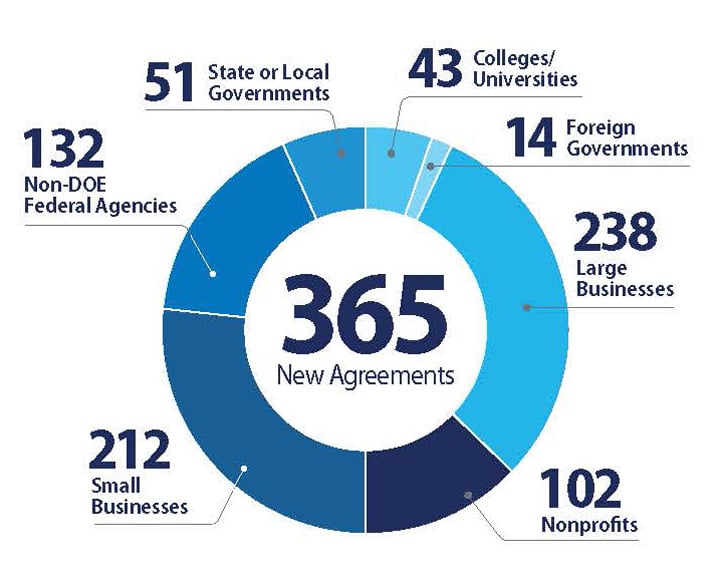Technology Partnership Program
NREL's Technology Transfer Office can help you determine the best partnership agreement to ensure your project's success by leveraging our world-class technologies, research facilities, and team.

See a sample of the partnerships we're managing through our summary of NREL's Fiscal Year 2024 technology partnership agreements.
Looking for Funding?
NREL offers numerous procurement opportunities through competitively placed contracts.
We do not, however, fund projects under technology partnership program agreements. The partner provides the necessary resources and, in most cases, covers our costs of providing technical services.
Partnership Agreement Steps
Follow these steps to initiate a partnership agreement with NREL. See separate steps for initiating nondisclosure agreements.
1. Contact Us
Contact us about partnering with NREL and to discuss your proposed project or need.
2. Determine Project Eligibility and Appropriate Agreement
- NREL will determine if the proposed project meets the laboratory's qualifications for a technology partnership agreement.
- If the project meets NREL's qualifications, NREL will determine which of our technology partnership agreements is appropriate.
3. Develop Statement of Work, Review, and Approve
NREL and the partner will develop a statement of work, which includes project scope, costs, deliverables, and schedule. NREL will submit statements of work for funds-in agreements and cooperative research and development agreements to the U.S. Department of Energy (DOE) for approval.
4. Review and/or Negotiate
NREL will draft an agreement that includes the terms and conditions and provide it to the partner. As appropriate, NREL may negotiate the technology partnership agreement with the partner.
5. Sign Agreement
Once the technology partnership agreement has been finalized, the appropriate parties will sign it. Note: If you're working under a cooperative research and development agreement, NREL will submit that agreement to DOE for a signature as well.
6. Send Funds and Start Work
The partner will send funds to NREL. Once NREL receives, processes, and authorizes the funds—which may take 5–15 business days—work may start. Note: This does not apply to shared-resource cooperative research and development agreements, which can begin work as soon as DOE final approval has been received.
7. Manage Commitment
Both NREL and the partner will manage their work and deliverables to achieve the project's goal toward commercialization.
Timeline
NREL generally expects technology partnership agreements to be executed within 45 business days. Longer timelines are generally the result of extended negotiations regarding agreement terms, partner funding delays, and/or negotiations related to the scope of work.
Agreement Types
NREL will determine which of the following technology partnership agreements suits your project's needs. View our agreement types matrix to learn more about what we offer.
NREL uses agreements for commercializing technology when a partner seeks highly specialized or technical services to complete a project. Under an agreement for commercializing technology, NREL may partner with businesses using more flexible terms that align with industry practice.
NREL uses a cooperative research and development agreement (CRADA) when it intends to collaborate with a partner on a project. It protects both parties’ intellectual property and allows the partner to negotiate for an exclusive field-of-use license for inventions developed under the CRADA.
Funds-In CRADA
This CRADA allows the partner to pay for all or some of NREL's costs under the project. However, NREL does not provide funds to the partner.
Shared Resources CRADA
This CRADA is for a joint research project between NREL and a partner to develop, advance, or commercialize an NREL-developed technology without funds changing hands. It must fit within the scope of a project at NREL that is funded by DOE.
NREL uses a strategic partnership projects (SPP) agreement when a partner seeks technical services to complete a project but does not intend to perform joint research. The partner provides NREL with the necessary resources and fully covers the costs of the work.
Interagency Agreement – Government
This SPP is used when a federal agency other than DOE funds NREL's work directly. DOE and the agency negotiate and enter into the agreement.
Funds-In Agreement
With this SPP, a nonfederal entity pays NREL to conduct a research-oriented project. This version of the nonfederal SPP has no agreement value limit and has intellectual property provisions that address inventions.
Technical Services Agreements
A technical services agreement is suitable for projects $500,000 or less in value, up to 3 years in duration, and funded entirely by the sponsor for services not expected to result in any inventions. A technical services agreement cannot be used for agreements with federal agencies. It has been preapproved by DOE, which means that terms cannot be changed.
Under these agreements, partners may use NREL's Energy Systems Integration Facility, which has been designated by DOE as a user facility to develop and evaluate energy technologies.
Non-Proprietary
DOE funds NREL's work under a non-proprietary user agreement and NREL staff may participate in the research.
Proprietary
NREL staff does not participate in the research work under a proprietary user agreement, but the partner must fund staff time to set up and oversee the project.
Contact
Contact a partnership agreements specialist with questions.
Share
Last Updated March 14, 2025
